April 12, 2022 // Diocese
Looking back on a life of service
Little is known about the early life of Father George O’Connor prior to the tornado that claimed the lives of his parents and many of his siblings.
He went on to lead a life of faith and service that led him to what is now the Diocese of Fort Wayne-South Bend. Here he became a Congregation of Holy Cross priest who in the 1920s started two ministries that thrived and continue today: St. Pius X Parish in Granger and St. Augustine Parish, the first in the diocese created to serve African-American Catholics.
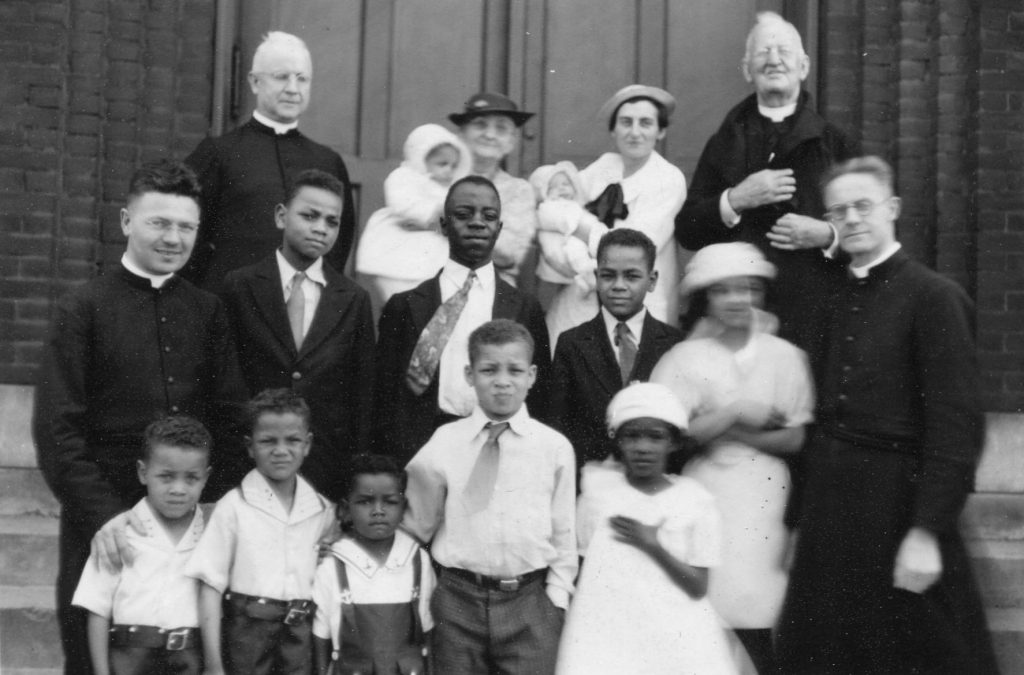
Photos provided by the Congregation of Holy Cross U.S. Province Archives Center
Father George O’Connor, CSC, upper right, stands with the Father Tim Murphy, CSC, upper left, African-American Catholic family members and two Holy Cross brothers in this photo possibly taken at the old St. Joseph Catholic Church building in South Bend. The parish pastor allowed Father O’Connor to celebrate Mass in the parish recreation hall for African-American Catholic families, a ministry that grew into today’s St. Augustine Parish.
The future Father O’Connor was born on Jan. 11, 1871. His family appeared to be living at the time near Saylorville, Iowa, just north of Des Moines, U.S. Census records indicate. Census records also show that the family had lived previously in Illinois, and moved from Iowa to Houston County in Texas. They moved again by 1890 to eastern Oklahoma, the 1890 Oklahoma Territorial Census said.
Bureau of Land Management records show John O’Connor registered claims for two approximately 160-acre parcels of land, which were located in Cleveland County, Oklahoma, west of Moore and Norman and east of the Canadian River.
Tragedy strikes
In the late afternoon on April 25, 1893, the skies turned dark and dangerous near the O’Connors’ farm. Around 6:30 p.m., a tornado, reportedly possibly more than a mile wide at one point, shredded the area where the O’Connors lived, leaving 33 people dead and at least 30 homes in ruins, the National Weather Service said in its list of the Top 10 Deadliest Oklahoma Tornadoes (1882-Present).
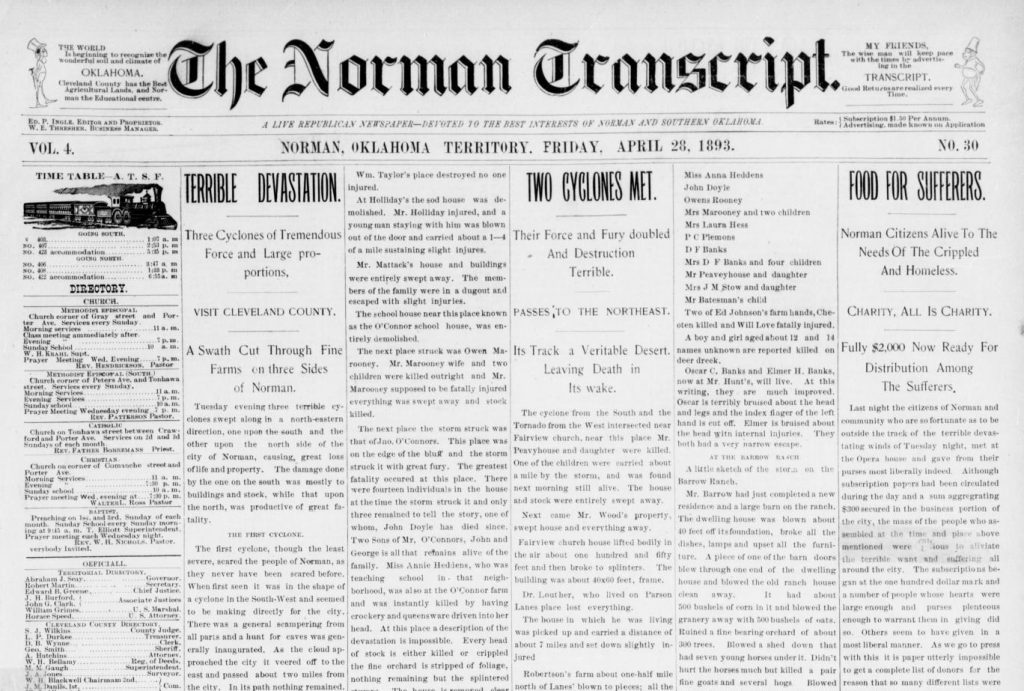
This image shows the front page of The Norman Transcript in Norman, Okla., as it reported April 28, 1893, on the aftermath of two tornadoes that tore through the rural area west of Norman, killing several members of George O’Connor’s family. O’Connor later became a Congregation of Holy Cross priest. (From the Oklahoma Digital Newspapers Collection)
The O’Connors and a few neighbors had taken shelter in their home. Of the 14 people reportedly there, only George and his brother John and John’s wife, Sarah, survived, news accounts said. George’s sister, Ann, was married and living in Norman, while brother Michael had stayed in Texas.
Though orphaned, George was age 22 at the time and took on the responsibility of settling his father’s estate.
It appears George also soon explored a calling to religious life. A January 1896 article in The Indian Advocate, a review published by the Benedictine Fathers of the Indian Territory (Oklahoma), reported George O’Connor was among several men who arrived on Dec. 1, 1895, at the Benedictine’s Sacred Heart Priory in eastern Oklahoma Territory to enter the novitiate of their order. He apparently didn’t stay.
News accounts from The Norman Transcript and that city’s The Democrat-Topic newspapers in 1899 mention George working for his brother-in-law, John Sullivan, at the latter’s grocery store and serving as an officer in the Norman Lodge of the Ancient Order of United Workmen, a fraternal benefits organization that sought better job conditions for workers and provided death and insurance benefits to workers and their families.
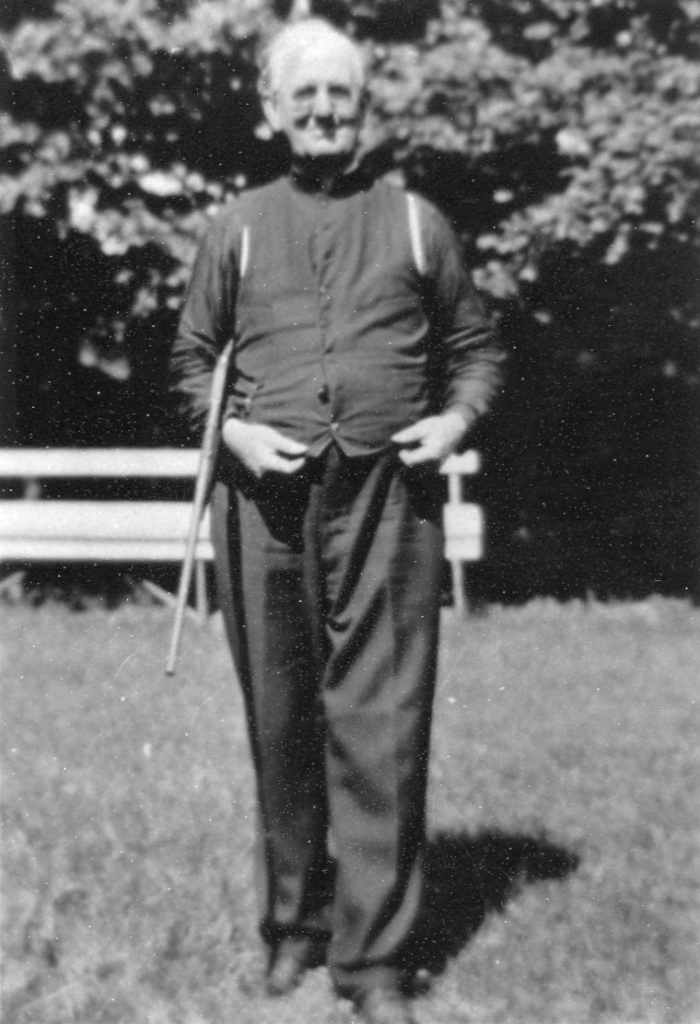
This photo shows Father George O’Connor, CSC, while he served from 1922 to 1928 as superior and director of St. Joseph’s Farm. The farm run by the Congregation of Holy Cross supplied food for the University of Notre Dame. While there, Father O’Connor started a ministry for farm families that grew into St. Pius X Parish, now one of the largest in the Diocese of Fort Wayne-South Bend.
Religious life
Beginning in February 1900, newspapers around Norman reported about George leaving the area to study for the priesthood at the University of Notre Dame in South Bend. He entered its Holy Cross Seminary in 1901 at age 30, it said in a short biography in “Decisions for Hope,” a 1993 publication of the Congregation of Holy Cross Indiana Province’s Social Ministries Commission. He made his final profession of vows in 1905 and was ordained a priest in 1906.
Father O’Connor first served as assistant superior at Holy Cross Seminary at Notre Dame, the “Decisions for Hope” biography said.
By summer of 1917, he had been assigned to the faculty at the Holy Cross order’s St. Edward’s University in Austin, Texas, according to the 1986 book “St. Edward’s University: A Centennial History,” by Brother William Dunn, CSC.
The 1920 U.S. Census lists Father O’Connor as serving at a parish in Eureka, Utah. He reportedly also served in Nevada, it said in his obituary printed Sept. 9, 1939, in The Tablet, a Catholic weekly newspaper published in Brooklyn, New York.
Lasting legacy
Father O’Connor then returned to South Bend, where he served from 1922 to 1928 as superior and director of St. Joseph’s Farm. Holy Cross brothers, sisters and priests worked on the farm to grow food served at the University of Notre Dame. Father O’Connor saw a need for ministry to nearby Catholic farm families, so he began offering Mass for them in the farm’s chapel, the “Decisions for Hope” biography said.
That outreach grew steadily, becoming St. Joseph’s Farm Parish in 1936, according to a history of St. Pius X Parish. Having outgrown the space, the rapidly growing congregation moved to its own land nearby on Fir Road and was named St. Pius X when its church building was dedicated in 1956, the history said.
Today, St. Pius X is one of the largest parishes in the diocese. It has built two new churches, a parish education center and more since 1956 to accommodate continued growth, the parish history said. It also bought an adjacent 10 to 15 acres of land for its athletic fields and new rectory, said Pastor Monsignor William Schooler.
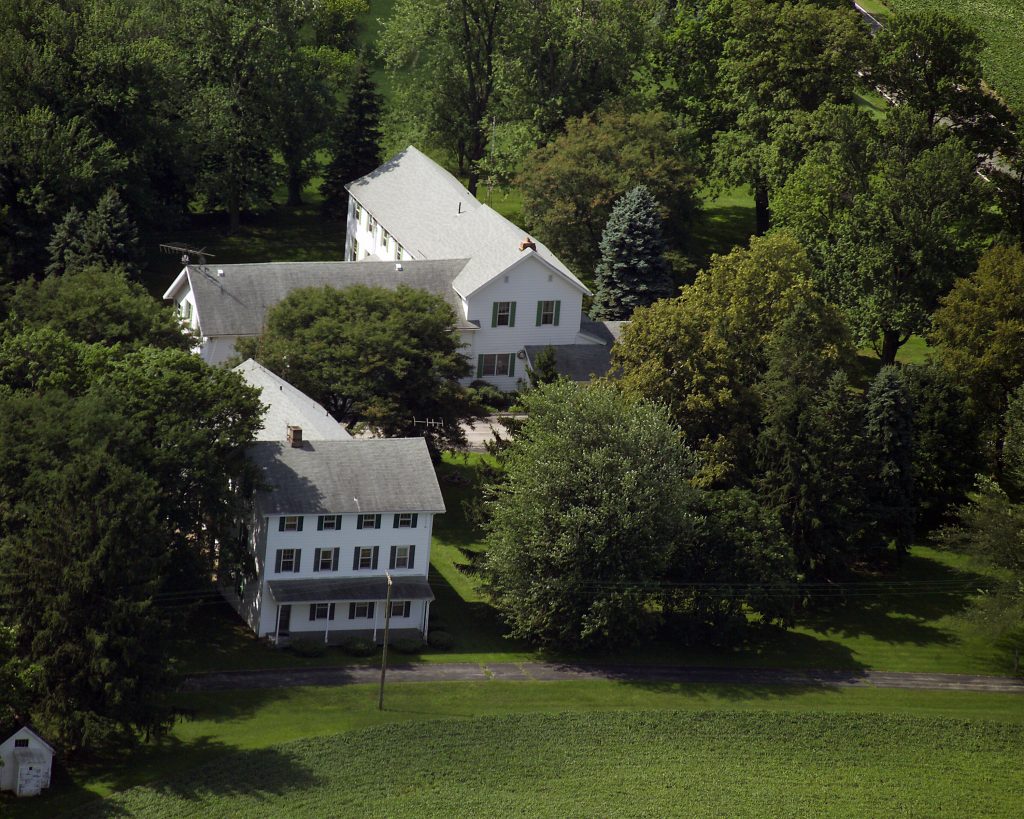
Provided by St. Pius X, Granger
This shows a modern photo of the former St. Joseph’s Farm, where Father George O’Connor, CSC, served from 1922 to 1928 as superior and director. Holy Cross brothers, priests and sisters lived at the farm and grew food for the University of Notre Dame.
Father O’Connor quickly devoted himself to a new need. After leaving St. Joseph’s Farm in 1928 to live in the Holy Cross community at Notre Dame, Father O’Connor learned of eight African-American Catholic families in South Bend who wanted to practice their faith but often found themselves unwelcome at white parishes in the city, the “Decisions for Hope” biography said. He set out to minister to them.
Some Holy Cross congregation members recalled Father O’Connor had a love for African Americans, but they didn’t know why, the biography said. Census and historical records offer a couple of possibilities:
The 1880 U.S. Census shows the O’Connor family had numerous African-American farm families as neighbors while living in Houston County, Texas. George would have been about age 11 at the time and likely knew youngsters at neighboring farms.
Race was also an issue in Austin, Texas, where Father O’Connor served at St. Edward’s University. White leaders hoped to push African Americans into living in one area on the east side of the city. In response, the Congregation of Holy Cross founded Holy Cross Parish in 1936 to serve the city’s African-American community, it said on the parish’s website, holycrossaustin.org.
In South Bend, Father O’Connor first needed a place to gather with African-American families. Father William Lennartz, CSC, then pastor at St. Joseph Parish in South Bend, allowed Father O’Connor to use the parish’s recreation hall to celebrate Mass for African-American families, it said in “Decisions for Hope.”
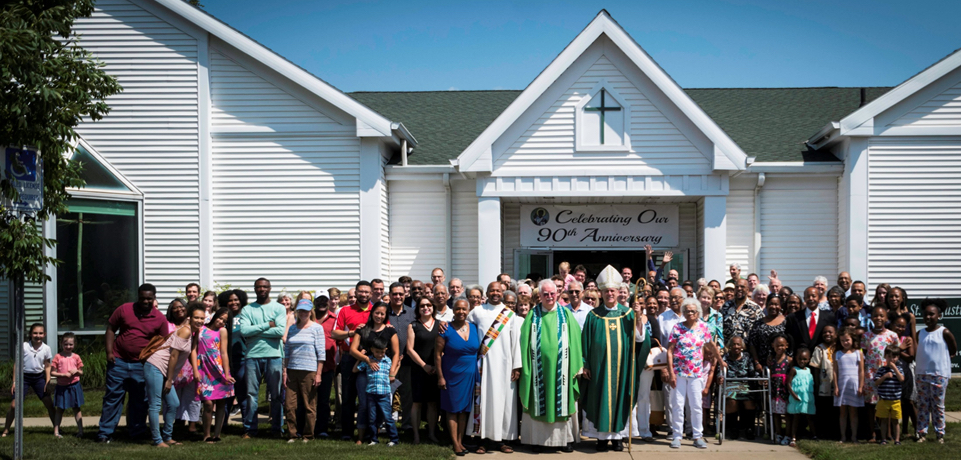
Provided by St. Augustine Parish, South Bend
Members of St. Augustine Parish in South Bend celebrated their 90th anniversary in 2018. In 1928, Father George O’Connor, CSC, started an outreach ministry to African-American Catholics that grew into St. Augustine Parish.
The ministry grew, and in 1936, Archbishop John F. Noll created St. Augustine Parish to serve African-American Catholics in the South Bend area, Father O’Connor’s biography said.
The church, now at 1501 W. Washington St., has evolved into one of the diocese’s more diverse parishes, welcoming people from a variety of cultural backgrounds. The Congregation of Holy Cross continues to serve the parish, with Father Len Collins, CSC, now its pastor.
Father O’Connor, who also provided food and other help to the poor during the Great Depression, lived to see his mission efforts bear fruit. He served at St. Augustine until 1936, when heart problems forced him to step aside, his biography said.
He died on Aug. 30, 1939, and is buried in Holy Cross community cemetery at Notre Dame. His legacy of faith lives on, however, through social justice and other ministries offered by the two parishes he helped found.
Priest’s social justice legacy lives on
Father George O’Connor, CSC, showed a strong interest in social justice during his life. The two parishes the Holy Cross priest founded in the South Bend area maintain that legacy and connection.
Father O’Connor, who died in 1939, is credited with founding the ministries that grew into St. Augustine and St. Pius X parishes.
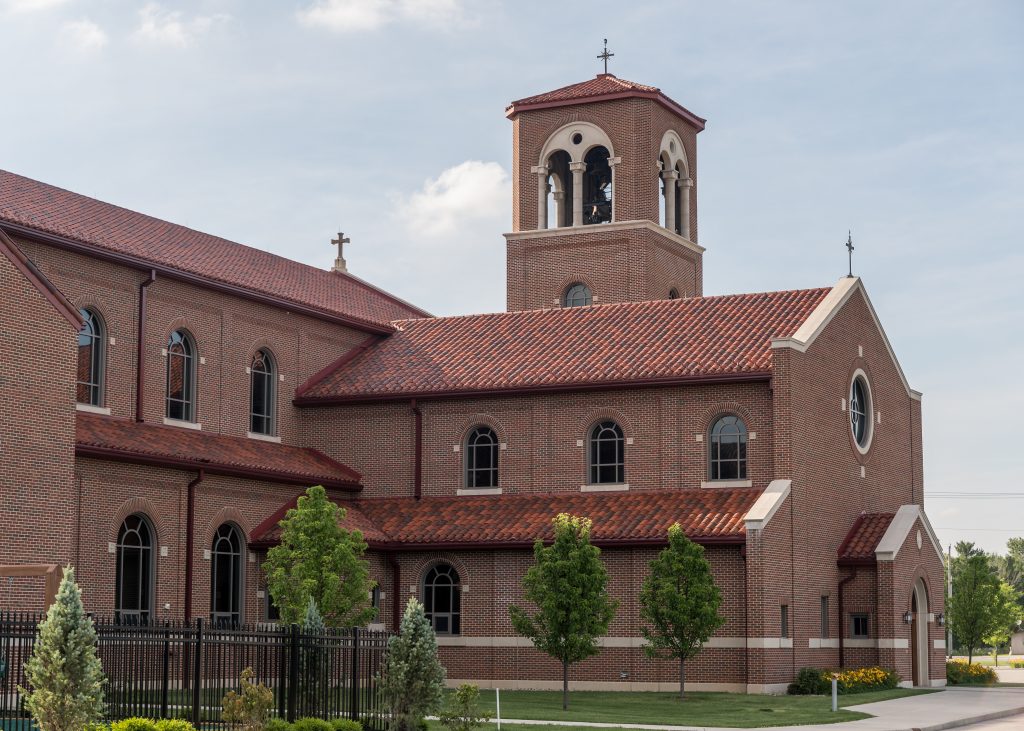
St. Pius X Parish in Granger grew out of a ministry Father George O’Connor, CSC, started in the 1920s to serve farm families living near the St. Joseph’s Farm, where he was superior and director.
St. Augustine has expanded from several African-American families that Father O’Connor initially served into a multicultural parish still rooted in African-American worship traditions. St. Pius X has sprouted from a Chapel Mass for farm families living near the former St. Joseph’s Farm to become one of the largest parishes in the Diocese of Fort Wayne-South Bend.
Most people attending the two parishes don’t know of their connection through Father O’Connor, a few parish members said. However, members of the two parishes cooperate in some areas:
• People from both parishes are active with the diocese’s Black Catholic Advisory Board, said Wendy Summers, an advisory board member and the Ministry Leader for Catholic Social Teaching at St. Pius X.
• The Catholic Social Teaching ministry at St. Pius X organizes many events attended by parishioners of both St. Pius X and St. Augustine.
• St. Augustine has a Tolton Ambassadors Corps group, which seeks through prayer and awareness to encourage the cause for sainthood for the late Father Augustus Tolton, who many people recognize as the first American-born, African-American Catholic priest. The Tolton group includes members from both St. Augustine and St. Pius X parishes, including Wendy and her husband, James.
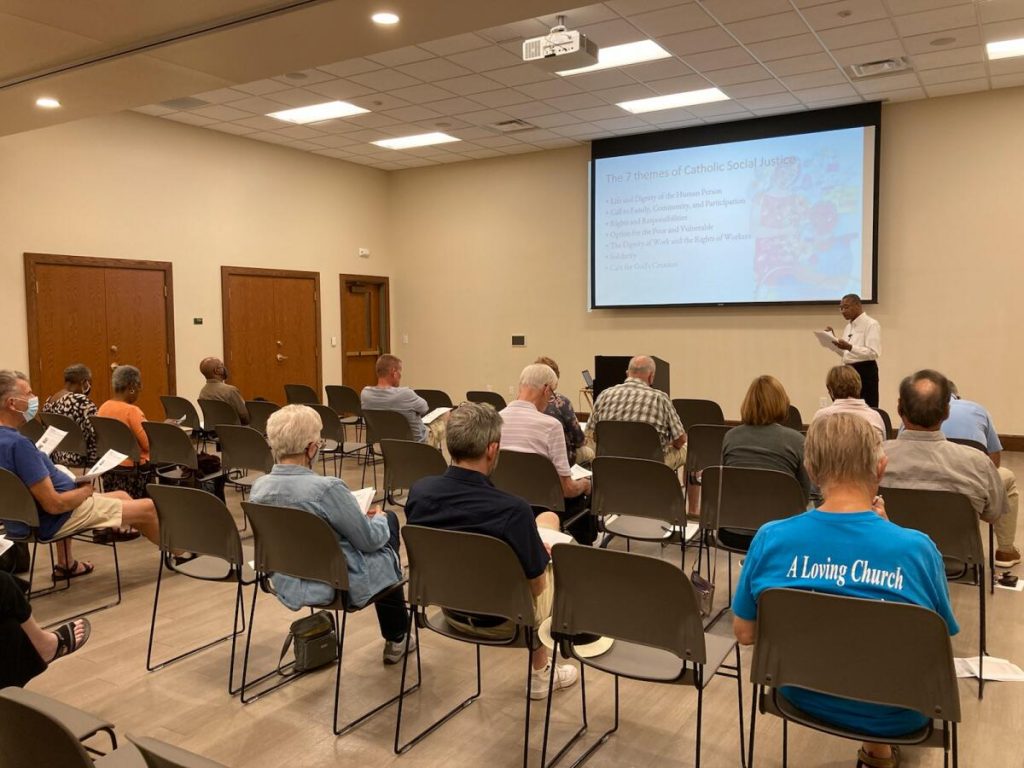
Catholic social teachings events at St. Pius X in Granger continue to draw people from that parish and St. Augustine Parish in South Bend, both of which trace their roots to the ministry of the Rev. George O’Connor, CSC.
Wendy believes the three efforts attract people from both parishes because they deal with issues of mending the brokenness in the world. “The issue and history of racism in our country is a break from God,” she noted.
The St. Pius X Catholic Social Teaching ministry’s winter book study, for example, drew four people from St. Augustine to read and discuss the book “A White Catholic’s Guide to Racism and Privilege,” Wendy said.
A woman from St. Augustine came to the St. Pius X Catholic Social Teaching group to ask if its members would help collect bicycles for criminal offenders who need transportation to work but don’t have an active driver’s license, Wendy continued. St. Pius X members collected numerous bicycles, and a parish couple paid to have the bikes tuned up for use.
Wendy and James also attend Mass frequently at St. Augustine.
“We go to St. A’s because we get filled with Black spirituality,” she explained.
She also leads the rosary for Father Tolton’s sainthood at 9:30 a.m. on the third Sunday of the month at St. Augustine.
Francine Henley, who has attended St. Augustine for about 30 years, began participating several years ago in social justice programs at St. Pius X. In addition to the topic, her connection also was built on relationship.
The Tolton group at St. Augustine had organized a pilgrimage to Father Tolton’s birthplace in Missouri and where he grew up in Quincy, Illinois. Henley happened to ride in the same van as Wendy and James and another St. Pius X couple, who talked about the Catholic Social Teaching activities at their parish and the topics they were discussing.
Henley then began attending social justice programs and events at St. Pius X. She invites St. Augustine parishioners to join her because their parish doesn’t have an organized social justice group or programs.
“I appreciate St. Pius for the programs,” she said. “They are large enough and big enough to offer those programs. And it just happens to be Father O’Connor’s other church.”
One of the people Henley persuaded to join her at St. Pius X events is Tanya Brown-Jones, who has attended St. Augustine since 1995 and joined the Catholic Church in 2003.
Some of the educational event topics have been helpful, such as one on the poor and vulnerable, Brown-Jones said.
“You see all these people on the streets in dire straits,” she explained. “You want to know how this happened and what you can do to help.”
Attending the events also has given her a sense of community with people she may not have met, she added.
Brown-Jones would like to see more collaboration among members of various parishes so they can get to know people from other cultures and backgrounds.
“I feel like people are sticking to their own parishes,” she said. “We should intermingle.”
The best news. Delivered to your inbox.
Subscribe to our mailing list today.






